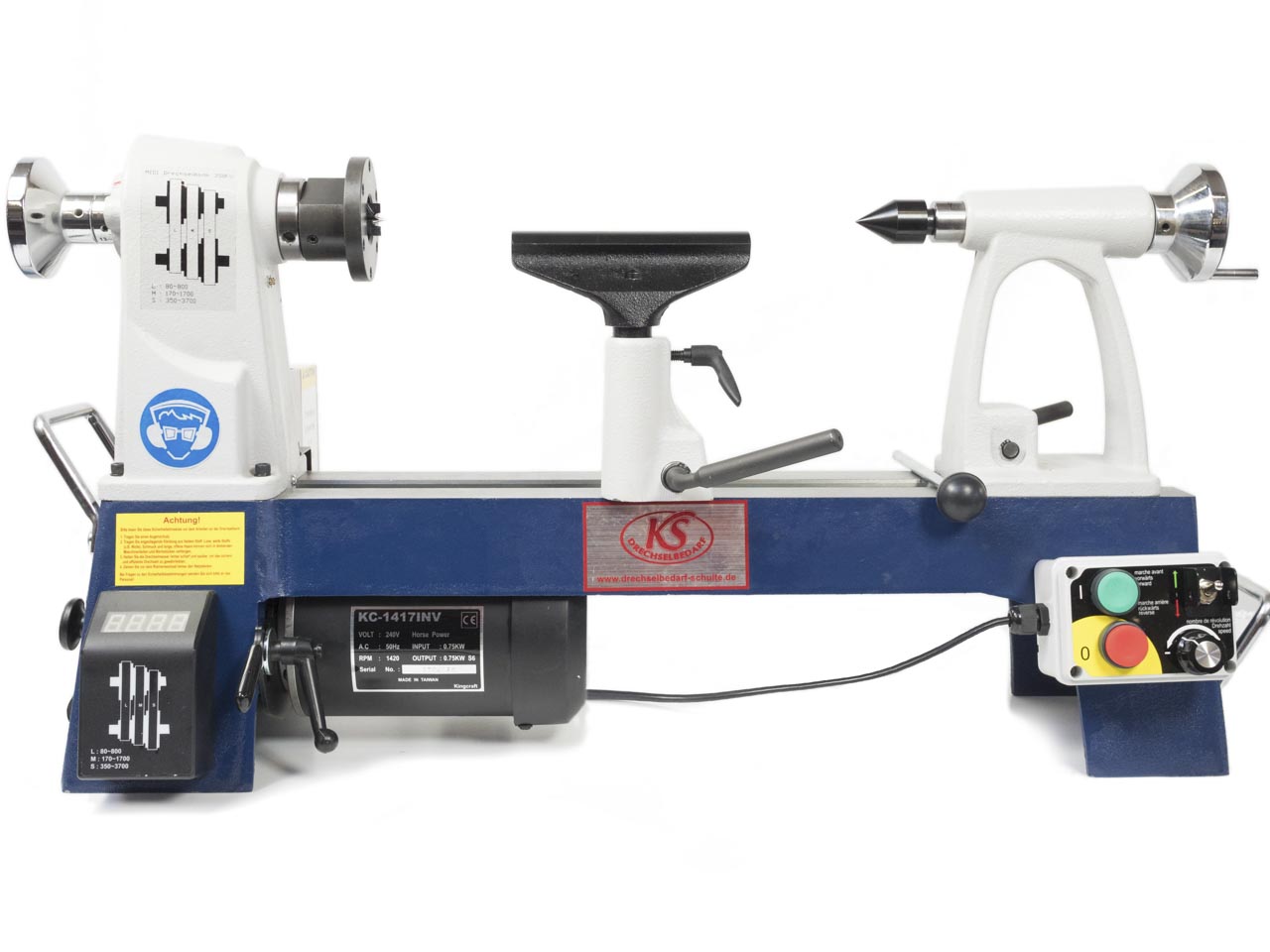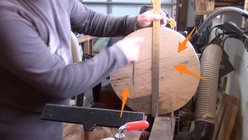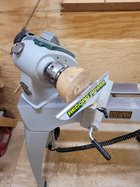Robert,
You've gotten a lot of good advice here, Mr. Coers in particular. I just went through this process a short while back; lots of interest in the endeavor, not much turning experience to speak of, and not a lot of knowledge about machines other than reading a ton of internet posts with two tons of opinions and the unavoidable marketing literature. I'll try to share what my own considerations and decisions were, and I may repeat some others' advice, but I have some additional details you might want to consider.
Regarding the rotating headstock vs sliding. You won't really save a ton of floor space with a rotating headstock (HS), since you'll simply find yourself standing a bit further over on the HS end when you rotate it. Just trading room on the left for room on the right. It will save some room, though, possibly up to 100% if you don't rotate 90 degrees or only stand directly in front (unlikely). The biggest advantage is going to be ergonomics, and if you have plenty of space in your shop (and depending on which machine you buy) standing at the tail end of a sliding lathe should only be marginally less ergonomic than rotating a HS, if at all. There is an ergonomic cost to sliding the HS as well, but again, this is trivial. Tedium is the bigger risk there, also trivial. In the end, I chose rotating mostly because I *do* have terribly limited space, and the lathe I wanted for other reasons had a rotating HS anyway.
Like any hobby that requires equipment, or anything else in life, I would always recommend getting the highest quality you can get. Pay until it hurts. Too many beginners get cheap crap to get started, but instead of eventually upgrading, they get discouraged with poor results, have zero fun, blame themselves, and quit. Sure, a skilled craftsman can compensate [somewhat] for poor tools, but this doesn't apply to beginners. As I used to always hear over on my car forum: "buy once, cry once". In the long run, you will save money buying better tools, but much more importantly, you will be free to focus on your growing skill, not overcoming limitations of junk equipment, and you'll enjoy the entire experience so much more. This does not apply to your first set of chisels, which can be of average quality and price since you will grind them down quickly while you learn to sharpen -- BUT, do get steel that will at the very least hold an edge.
Speaking of upgrades, one thing that people did not mention is spindle size. You're shopping right in the area where the lathes use 1" and 1.25" spindles. Everything mounted on the spindle (chucks, etc.) will be sized accordingly. So, if you buy a 12" lathe and decide you just need a bit more swing (or a bit higher quality), then you have to buy all new stuff for the 1.25" spindle. That can get expensive. I bought my lathe that has a 1.25" spindle for this reason. As many suggest, try to go large, but you don't need a 24" swing, based on what you've stated. A 14" to 18" lathe is your field. Most banjos are about 2" above the bed, so a 14" swing equates to a 10" diameter piece without too much hassle. Also keep in mind that you will be needing extra room for rough blanks before you get them into round. So, that 18" lathe really is not too big for what you are considering. Price goes up significantly after 16" though.
As alluded to above, consider your shop size. Don't just set aside room for the lathe, but you also need 4 feet of clearance in front of it, and if turning off the end, add it there too. Also, you'll need a bench or stand for your grinder, and the same clearance. You might get away with three feet around the lathe, but that's pretty tight and I wouldn't consider that safe for my own use. You also don't want to back up away from the lathe and keep bruising your a** on the corner of your workbench constantly.
The mass of the machine matters. You ideally want your mass to be concentrated right in the center of rotation around the spindle. Sine that's not really possible, you want to be as close as possible. Get a heavy machine. It helps with *every* piece, not just the big wobblies. Lots of people add weight to their stands, and that's great for keeping the machine from walking around the shop with a wobbly, but it doesn't really mitigate vibration like having a 16-ton lathe bed would. I exaggerate to make the point. A longer bed will also vibrate more, all other things being equal. You want ROCK SOLID, which also implies sturdy construction. Take a look at pictures of a Robust, Vicmarc, or a Oneway lathe (with the cool whale spine) and then compare to the sheet metal construction of a HF lathe. Mass = expense, but it's probably one of the top five attributes affecting performance.
Sticking with machine attributes a bit longer, we get to power. This one is simple. 210v > 110v. 2hp > 1hp. Variable speed is an absolute necessity. There are multiple kinds of variable-speed drives, with multiple controllers. That's a whole 12 conversations by itself, but there is a hierarchy in terms of quality. As always, higher quality costs more. You will do fine with the best two or three types. There is discussion and some disagreement about the newer servo motors. Personally, I love mine, but don't have a frame of reference, so I will not make a suggestion. Maybe I bought into marketing hype, or maybe it's actually better. I am not taking a position, because I don't have expertise here. Do a bit more research, pick out your top two or three for performance reasons, then get the best one you can afford. Naturally, these things don't come a la carte, but it should be a line item on your pros/cons list.
Now, precision. Most modern machines come with bearings made in Taiwan (that's a good thing). The casting and machining of the HS also affects precision. Also with bearings, there are machines with two bearings, and some with three. Debate follows this too. My reading was that machines with two bearings make their owners very happy. Machines with three bearings make their owners happy. My personal opinion is that the machines with three bearings are likely slightly more precise -- perhaps/probably imperceptibly for woodwork -- but more importantly, they will last longer in theory. That being said, plenty of two-bearing owners have stated their bearings have run solidly for two, three decades. I considered it a very-nice-to-have but not a dealbreaker. If I planned on doing production work, I might care more about longevity. In addition to the bearings, your precision is affected by the tolerances of the HS, TS, and bed. It's not a CNC machine, but if your spindles don't align decently, you'll have some difficulty achieving those astonishing results.
Noise level. Nobody talks about this one much, but it was and is extremely important to me. I hate, hate, hate loud noise. A servo motor is whisper quiet. Literally. There is no cooling fan. I can hear someone whisper from ten feet away while a spindle turns at 1500 rpm on my lathe. It was so important, I sacrificed swing for it (and for the larger spindle). It's bad enough that I have to figure out how to put my dust collector in a remote area, but at least I can do that. I can't put the lathe on the other side of the wall. The only noise I hear when I turn is the chisel against the wood. This is one thing where you really do need to be in the same room with the lathe to assess, which I know is difficult. This adds a great deal of Zen for me. Ask Odie what that means...
If you haven't figured it out by now, I chose the T40. Most people shy away from it because it is a few hundred more than a comparable lathe, and they made the unfortunate decision to make it a 14" lathe, although that's probably the practical limit of the motor. This lathe, like any other, is not for everyone. The upsides are: it has a decent swing (I would much prefer 18", would settle for 16", and really kinda hated being forces to go with 14). It has the 1.25" spindle. Three bearings. Rotating HS. Precision. One of the heaviest midi lathes out there with nice thick castings. It is SO quiet. Higher build quality in general, in terms of switches, controller, etc. The downsides are: it has that 14" swing. Note that I left the price out of this list. Is it more expensive than a lot of 12" lathes, or even some cheaper 16" lathes? Sure. But not when you compare apples to apples. Start with the spindle, and go from there. You might find it to be one of the best values out there. Yes, I am offering a recommendation, but I'm not on the take. I put a lot of research into the decision, and it's a pretty impressive machine for the money. But sure, you can get a 12" lathe for $1,000, maybe even less. If you never upgrade, you did well. If you do want a bigger lathe, you're pretty much starting over with the lathe and accessories that are mounted on the spindle(s). To my mind, that savings right there justified the "extra" cost the T40. Of course this is my lifer lathe, but two years ago, before I moved, I was in my forever house.
Generally speaking, as so many have said in so various ways, if you want a quick rule of thumb: stay away from Grizzly unless you can find one of their older ones that doesn't suck (and usually are not for sale). Stay away from no-names. Stay far, FAR away from HF, Sears, and Shopsmith (jack of all trades, absolutely sucks at everything). Approach Laguna with caution. Be open to Jet, Harvey, Powermatic, Record Power, Nova and their ilk. You will find that they are all priced according to the you-get-what-you-pay-for rule, although Powermatic is by far the most expensive in the group, kinda wants to be in the top tier. If you're loaded, you've already bought a Vic, Robust, or Oneway, and you're definitely getting what you paid for. Actually, that goes for the cheap ones too, except you'll get even less than you paid for. Many people think they have their lifer lathe, but consider resale value anyway. Mid-level and higher lathes all hold their value. I would not touch a used low-end lathe, simply becasue if it was junk in the first place there's a good chance it was treated like junk all its life too.
Now, there's one thing I see all the time that I disagree with. The certain advice that says "you pay as much for accessories as you pay for the lathe". That's nonsense. A startup kit is a fairly fixed amount. In the beginning, it might be the same and probably will be (thus the rule), or maybe more if you get a really cheap/small lathe, or maybe less than what you spend on the lathe if you get a nice one (for that size). By the end of a lifelong addiction, you'll spend vastly more on stuff than on lathes, from what I understand. To start out, you're looking at about $1,000 to $1,400 for that stuff to get started, no matter what lathe you buy. Yup. You need chisels (I would say $200 there, but can start with as little as $80 with the classic Benjamin's Best set), a low-speed grinder (don't skimp here either, a grinder also needs to run true, and the very popular 2hp Rikon is a good value and comes with two wheels to get you started, but budget for replacing those in the near future) at $200-$300, some grinding jig stuff, maybe $150 there, dust control for at least $200 and another hundred or two for pipe/hose, a nice chuck at $250 and some more dollars soon to buy a couple more jaw sets, then $300 or so on piddles like calipers, a bit more PPE that you don't yet have, the inevitable minor workshop build-out for storage and perhaps a bench for the lathe and one for the grinder. If you don't have a chainsaw, add a few hundred more for that. Maybe that's not Day 1, but it's Day Soon. The point is, if you buy a Robust, you don't also have to drop another $8K on some beginning chisels and a grinder.

hopewoodturning.co.uk



